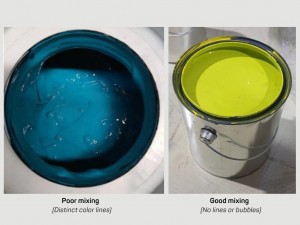Mistakes to avoid while mixing paint colors
Published on: 23 September 2021Color performance is a major focus for the paints and coatings industry. Physical and chemical properties of formulations such as viscosity, friction, hardness, density, and gloss depend on pigment types and concentration. Besides these considerations, achieving that perfect shade entails a few other parameters such as machine quality and maintenance.
For consistency in mixing and the best results, be careful of not making these operational errors:
For paints manufacturers
- Incompatible base paints and colorants
Due to changes in VOC regulations, the levels of glycol and co-solvent in most colorants have been lowered. These altered formulations may not work well with some dispensing machines and base paints. It is advisable to verify compatibility to achieve maximum operating efficiency and get the desired shade variant.
- Viscosity pickup inside the canister
Inconsistent fluid viscosity can jam your canister. Such lapses lead to wastage and the need for costly equipment replacement, thus increasing your total cost of ownership.
- Defective machines
Leaky nozzles cause impurities and pollutants to contaminate the colorant, severely diminishing mixing efficacy. Scheduled maintenance and routine checks of mixers and shakers can help prolong performance.
- Foam in colorants
Surfactants reduce the surface tension of fluids and cause bubble formation during dispersion. Excess foam prolongs production time and produces unwanted variations when dispensing air-filled colorants.
- Contaminated storage conditions
Filthy storage and careless handling provide the perfect environment for bacteria to compromise the integrity of the paint film inside your canister. Bad odor from damaged colorants can also be hazardous for operators.
For retailers and distributors using dispensing machine
- Incorrect colorant filling and optimal fill levels
Remember to shake the colorant before each fill, especially if you are using an inorganic colorant that tends to settle. Check with the manufacturer to recommend the best practices to optimize performance. It is ideal to fill the canisters at the end of the day as any air added will be worked out of the lines overnight via recirculation and agitation.
- Clogging of nozzles
Purge colorants and maintain your dispensers to avoid clogging inside nozzles. Fill water in the brush assembly to clean the nozzles periodically and reduce maintenance costs.
For retailers and distributors using mixers and shakers
- Wrong positioning of cans
Placing your paint can in the wrong position can lead to inconsistent and ineffective mixing. Always keep it in an upright position for faster homogenization and uniform color shade.
- Negligence of safety protocols
Read the instructions that come with your wiring guidelines before attempting any electrical work. Make sure to secure all plugs and doors while you are mixing paint. Push the emergency button on your equipment to stop immediately if a problem occurs.
General operating rules to follow
- Release the emergency button before initiating the mixing process
- Check how to place a single can vs multiple cans
- Select the right settings to activate a single can or multi-can mixing
- Choose the right mixing time settings for better output
- Remember to close the door before activating the mixing program
We at Fast & Fluid Management Asia believe in co-creating future-proof paint tinting and mixing solutions with our customers. Visit our website to learn more about the latest range of intelligent automatic mixers and dispensers to boost your business.

